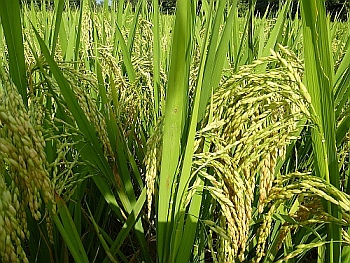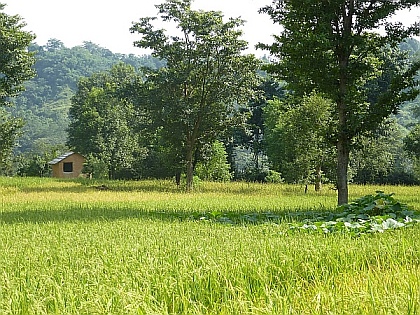The System of Rice Intensification (SRI) is now gaining a foothold in the mountain regions of India, with more than 3000 farmers cultivating it over 58 ha in 2008 in Himachal Pradesh alone (1). In India, the method is leading to a surge of innovation among farmers, with regions adapting the principles to their specific needs (2). This article takes a look at two such farmers in Himachal Pradesh who have identified a problem and a means of solving it.

SRI significantly increases production in rice (Photo: Chicu Lokgariwar)
The area:
Rajol village is located in Rait Block, in the beautiful Kangra valley of Himachal Pradesh. The village has a population of 1300 people, and is predominantly a agricultural community. CORD has been working extensively in the area following their model of sustainable development which looks at overall improvement of rural lives.
The problem:
SRI entails marking drills and then planting the seedlings in these furrows. Kartal Singh has been practicing SRI for four years now, but has not increased production beyond 1 Kanal (approximately 384 sqm) which is what he started out with. He explained that the soil is clayey. This means that when the land is ploughed and levelled (a process called marchain), it tends to become extremely fluid. Markings disappear before the seedlings can be transplanted causing frustration.

Champa Devi's rice fields in Rajol, Kangra (Photo: Chicu Lokgariwar)
The solution:
Champa Devi, the president of the CORD-established farmer's group, has also been practicing SRI since 2006. Since then, she has increased the land under this method from 1 kanaal in 2006 to 3 kanaal today. She has also experienced the same problems with the clayey soil that Kartaal Singh has. This led her to modify the method of marchain to incorporate a two-day rest period before transplanting the seedlings. This allows for the formation of a dry crust on top of the fields which makes marking of drills easy.

Champa Devi- organic farmer (Photo: Chicu Lokgariwar)
Significance:
SRI is a technique that vastly improves yield. However, the rate of adoption of this technique among farmers is less than might be expected. One reason for this is the emergence of local problems like the one illustrated above. Innovative farmers like Champa Devi are best equipped to solve these problems empirically. Sushma Devi, another farmer from the village, has also adopted this method in her fields. This also proves that such locally devised solutions are readily accepted.
Acknowledgement:
CORD is working extensively in the area. Mr. Narendra Paul, Programme Manager suggested and enabled this field visit and also explained CORD's mission and method of work. Mr. Parvesh Kumar, Community Development Worker, guided and educated the author during the visit.
References:
1. SRI-India













